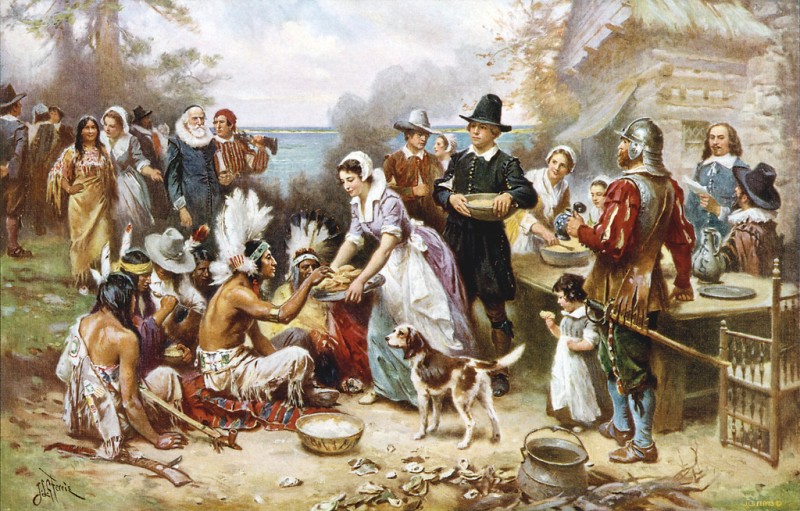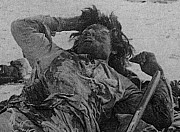First Thanksgiving: Forget what you learned in school
By Cindy Yurth
Their arrival was not met by a band of happy-go-lucky savages eager to share their wealth with the starving newcomers. The tribes were wondering how the palefaces were going to fit into the power structure, and whether they should befriend them in the hopes of gaining new allies, or dispatch them on the spot to preserve the status quo.
"Massasoit wanted to make friends with the Pilgrims so he could get their help against the Narragansetts," Hopkins explained. "It worked."
Although Squanto, a Wampanoag who spoke English, had taught the Pilgrims what to plant in the New World, the two races were not quite on friendly terms by the time of that first harvest.
"What most history books don't tell you is that the Pilgrims limited the number of Indians who could attend that first Thanksgiving," Hopkins said. "They made sure to seat a white guy on each side of each Wampanoag warrior, just in case something happened."
By Gale Courey Toensing
Probably that it’s perceived that we welcomed them. Yeah, they think we were just standing there waiting for them and welcoming [them] and one guy handed them the turkey and another guy handed them the carving knife and they all went to dinner—it’s just ridiculous! What really happened was there was no contact with them for six months. But we were watching them and seeing what they were doing. And it was Samoset who was from Maine and was down visiting who made the first contact—I always figured they sent the guy from out of town to do it! But then there was a feasting event the next fall that’s been interpreted as the first Thanksgiving. But it wasn’t even dubbed that till the 19th century.
By Vincent Schilling
The Pilgrims were most likely nervous—the Wampanoag outnumbered the Pilgrims two to one, but it certainly wasn’t the happy picture put forth in many history books. According to Mashpee Wampanoag Tribal Historic Preservation Officer Ramona Peters, “It was Abraham Lincoln who used the theme of Pilgrims and Indians eating happily together. He was trying to calm things down during the Civil War when people were divided. It was like a nice unity story.”

Why Falsify Thanksgiving?
Why do we celebrate a happy-go-lucky feast between Pilgrim and Indian "besties"? Like Indian mascots and other stereotypical depictions, it obscures America's history of crimes against Indians.
Thanksgiving is for sociopaths
I don't have anything against turkey. But I can't abide a holiday that denies its genocidal historical context
By Robert Jensen
That description is accurate, at one level—my rejection of Thanksgiving is more intellectual than emotional, a political decision to reject that distortion of history. Whatever the actual details of the 1621 celebration involving Pilgrims and Wampanoag Indians (and there is ongoing debate about various factual claims), Thanksgiving is one way the dominant culture minimizes or denies the larger historical context of Europeans’ genocidal campaign against indigenous people to acquire the land base of the United States. Without that genocide, there is no United States. For the victors’ descendants to take a day off to give thanks without acknowledging that seems, well, just a bit sociopathic.
By Ruth Hopkins
By Stephen Lendman
By Dennis Zotigh
When children are young, they are often exposed to antiquated images of American Indians through cartoons, books, and movies. But Thanksgiving re-enactments may be their most active personal encounter with Indian America, however poorly imagined, and many American children associate Thanksgiving actions and images with Indian culture for the rest of their lives. These cultural misunderstandings and stereotypical images perpetuate historical inaccuracy.
Comment: For more on Thanksgiving myths, see Thanksgiving Is for Celebration Only? and Stereotypical Thanksgiving Paintings.


No comments:
Post a Comment
Note: Only a member of this blog may post a comment.